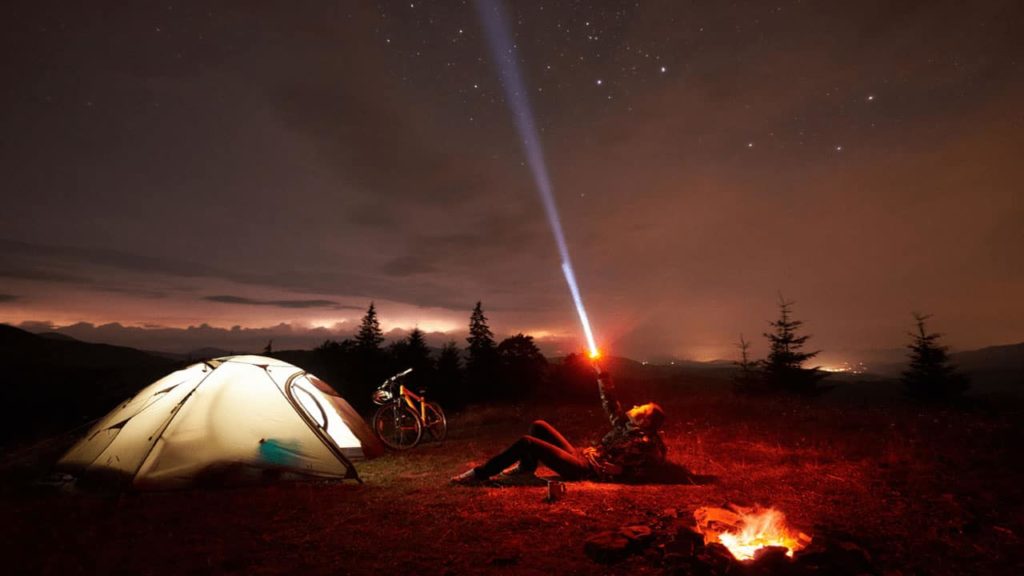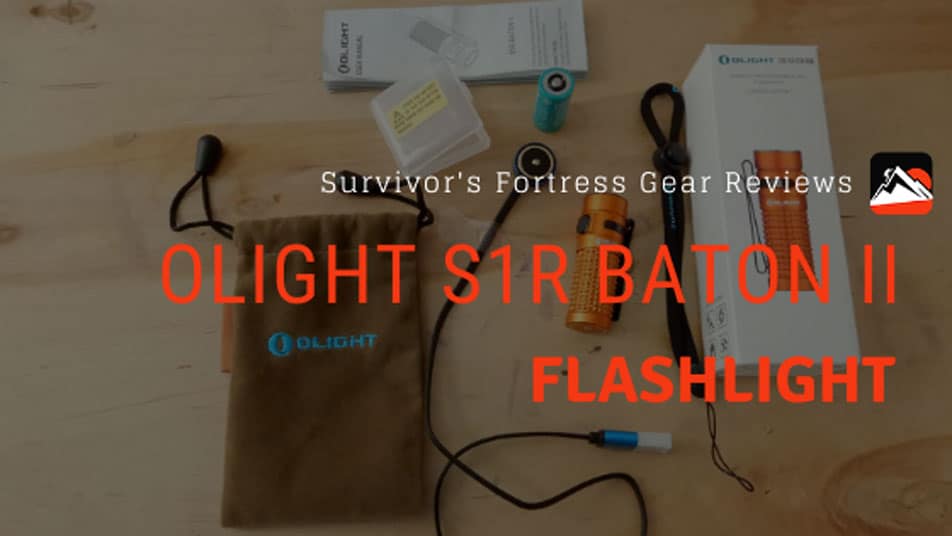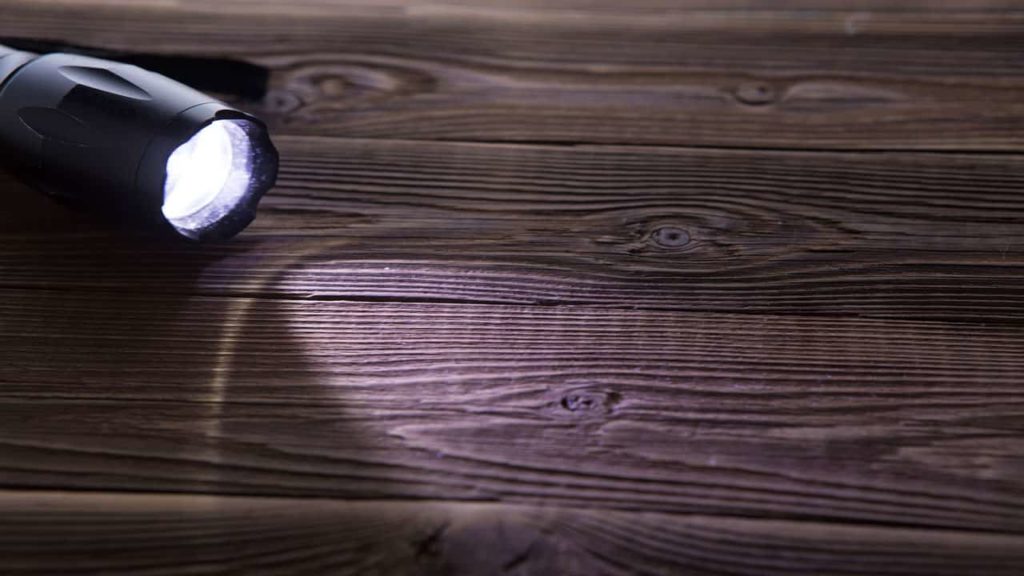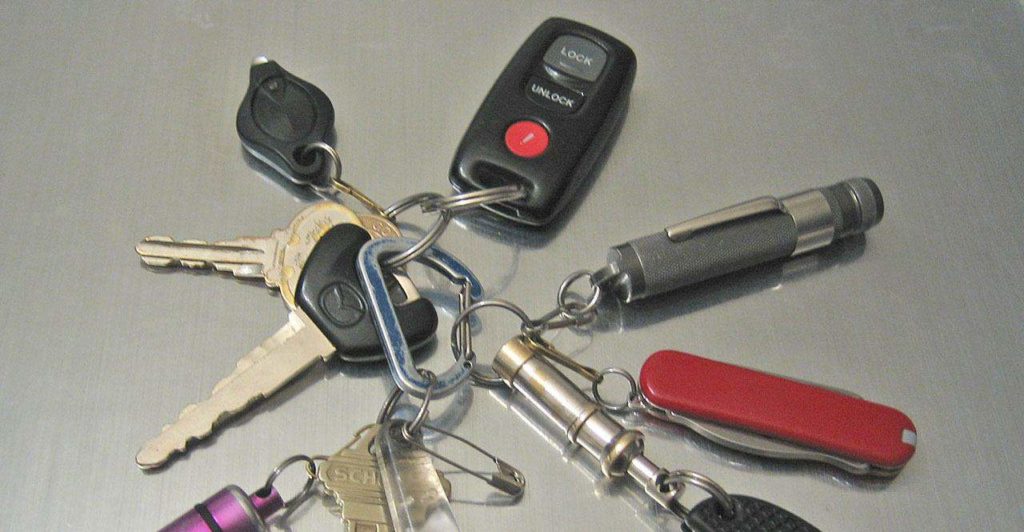Contents
When things go wrong, it doesn’t always happen on a bright sunny day. Whether it’s an emergency at night or in a location without light, you need to have a reliable source of light. The recent events in Texas have illustrated how fragile the power grid is. We’re just a snowstorm or terrorist attack away from being lost in the dark.
While everyone should have a headlamp in their bugout bag, not everything has you on the run. Headlamps suck when you’re in a group as you all end up blinding each other. A power outage at home or being in a stranded vehicle means you need area lighting, so a lantern is a great tool.
The lantern was one of the original forms of portable lighting: a candle flame encased in a glass housing to give 360-degree coverage. The bail on the top allowed for easy hanging and carrying. This eventually morphed into a liquid fuel lantern that used a fabric mantle to give more light than a single flame. Fast forward to today and the light source has switched from fire to an LED emitter. Durable, efficient, and no off-gassing has made the LED lantern the go-to for portable area lighting.
Like most things today, we are buried under options. To paraphrase the opening line of A Tale of Two Cities, we live in the best of times and the worst of times. Anything you want probably exists, but it’s becoming harder to figure out which is the right option.
That’s where we come in. It’s our job to be the gear nerds and figure out what’s best. It helps to work in the business, as I get to play with this gear at work and get feedback from customers about what lanterns function well. We break it down into our favorites.
How to Choose a Stellar Emergency Lantern
Choosing a lantern is no Herculean task. With a little patience, you can find a model that fits your budget, has all the qualities of a good lantern, and will not let you down in the wilderness. Before we list out the best emergency lanterns that money can buy, let us quickly take you through a few points you should bear in mind while picking one.
Brightness: A lantern is only as good as the illumination it can produce. Your lantern should produce neither a measly beam of light like that of a night lamp, nor should it produce light that makes you want to cover and protect your eyes. Unless you’re on the lookout for a lantern that can produce a floodlight effect, we recommend that you pick models that are made from non-glare frosted plastic.
The brightness of an emergency lantern is measured in lumens. This is a unit that describes or measures the total amount of light emanated from an apparatus in any one direction. Pick an emergency lantern that has a brightness of no more than 250 lumens. Apart from lumens, brightness is also determined by both optics and design.
Battery: While you can buy an electric camping lantern, we suggest you go for one that’s powered by batteries. These lanterns are safe to carry on camping trips and can be taken into the tent without worrying about fire hazards.
Battery powered lanterns work on both rechargeable as well as non-chargeable batteries. It always helps to carry extra batteries and an additional bulb on your camping trip. Battery powered lanterns are generally made from plastic, weigh barely a few ounces, and come in various sizes and shapes.
Never use lithium or lithium-ion batteries in your lantern. Only use alkaline batteries in your lanterns. You can extend the life of these batteries by storing them in a warm and dry place. Many of the latest lanterns are designed to run for several hours on a set of alkaline batteries. Be sure to pick a model that has a higher battery duration.
Adjustable brightness: One other criterion that is fundamental is that the lantern’s light must be adjustable. This will let you burn it bright in a forested campsite when the moon isn’t up, then dim it to a warm and pleasant glow once you’ve cozied into your tent.
Solid construction and durability: Longevity is just as important as performance. You need to pick a lantern that can withstand not only a sticky finger or two, but also an occasional splash in the wilderness. Check whether the lantern has a lot of extraneous parts that may break after a few uses. If the lantern has a lot of parts, check to see whether they’re made of weak plastic or a strong, durable material. Some lanterns are made from strong materials and can withstand a fall from as high as seven feet.
You will also need to check whether the lantern is waterproof. Remember, water resistance is different from being waterproof. Most lanterns on the market have a rating of IPX4, which indicates their water resistance level. However, there are some models that are not just waterproof, but also float well.
Reasonably priced: Last but certainly not least comes the price factor. The market is flooded with both expensive and cheap models. Depending on your usage, pick a model that fits your budget. If you research well enough, you’ll find dozens of reasonably priced lanterns that do their job. Remember to check the reviews and sift through more than one site before you zero in on a lantern to buy. You can get some impressive discounts on striking brands via most online portals that sell lanterns.
You might want to also check our best hand crank flashlights article.
Our Picks for Best Emergency Lanterns
1. Tough Light Rechargeable Lantern – Best All-Round Emergency Lantern


If I put together a list of features, I want in an emergency lantern, we would end up with the Tough Light. I want a rechargeable lantern that will charge phones – one that is bright, waterproof, tough, and at a reasonable price.
The Tough Light covers all of those bases, plus has a small flashing red LED that makes it easy to find in the dark. The 400-lumen maximum output gives enough light to illuminate a room or campsite without leading to short battery life.
The 6000 mAh battery will allow you to charge two cell phones. You can charge the light from any USB so that it will work in a vehicle, at home, or with a solar panel in the field. It has multiple modes, including a flashing SOS and various light levels.
The Tough Light has an IPX6 rating for waterproofness and can stand up to heavy rains and high winds. It also displays high impact resistance, with it being drop tested from a height of 5 feet.
The light quality is a stark white that doesn’t set a warm, romantic mood, but that’s fine for a piece of gear aimed at safety. For camping, you may want the Black Diamond Apollo, as the lighting is softer.
The price of this light is very reasonable based on the quality and features. The fact that it doesn’t require replaceable batteries will save you a lot of money over time. Furthermore, the convenience level is high since we’re all used to keeping our USB devices charged.
Specs:
- Weight: 1 lb. 15 oz
- Size: 3.5″ wide X 7″ tall
- Run Times: High 400 lumens for 30 hours
2. Energizer LED Camping Lantern – Best Budget Lantern


Batteries weren’t enough, so Energizer expanded its line-up of products to include lighting. The lights are a meager price for a big brand name, but pretty solid performance-wise.
Energizer’s Weather-Ready Emergency Area Light is a 500-lumen lantern that is IPX4 weather resistant. It will run on D-cell and AA-sized batteries and this battery compatibility expands its versatility as an emergency light. FYI – it will only run on low with AA batteries.
Energizer’s Emergency Area Light has a 500-lumen high mode and 50 lumen low mode, plus a nightlight. The power switch glows in the dark, so it makes it a breeze to find the unit when the power goes out.
The diffuser and LED combo make for a bright but soft light that isn’t hard on the eyes. I would have liked a medium level at around 200 lumens, as you don’t always need full power when eating at the table. This would also extend battery life when 500 lumens isn’t required.
The price of this light is the lowest of all the ones we reviewed, making it a good choice if you need multiples. Having a few lanterns throughout your house makes it easier to manage in case of a power outage.
Specs:
- Weight: 1 lb. 10 oz
- Size: 4″ wide X 8″ tall
- Run Times: High 500 lumens for 150 hours
- Low 50 lumens for 650 hours
Check out our recommended rechargeable flashlights article.
3. Black Diamond Apollo Lantern – Best Bugout Bag Lantern


Black Diamond makes my favorite headlamps, so I wasn’t surprised that their lanterns were solid performers. I use one of these lanterns when car camping. With flip-down legs and a hook for hanging, it can be used on a flat surface or hung inside the tent.
It sits plugged in charging at home, so I have a charged light exactly where I expect it if the power goes out. Leaving it plugged in doesn’t hurt it, as it shuts off when fully charged.
The Apollo lantern isn’t as bright as some of the other competitors on this list, but at 250 lumens it’s bright enough for most applications. It lights a tent, picnic table, or room well enough to do just about any task. Like most Black Diamond headlamps, the Apollo lantern is dimmable and has a strobe mode for emergency signaling. With an IPX4 rating, it will withstand splashes and light rain, but won’t stand up to a dunking in the lake.
Unlike many other models we’ve looked at, it is rechargeable via USB and can run with alkaline AA batteries. You can also charge your phone or other USB devices from the lantern. This means you can charge it from a solar panel during the day, whether at home or in the field. The built-in power meter also lets you know how much battery life is left in the Apollo.
Specs:
- Weight: 12.1 oz
- Size: 3.1″ wide X 4.72″ tall
- Run Times: High 250 lumens for 6 hours
- Low 10 lumens for 30 hours
Learn more about the best 1000 lumens flashlights by clicking here.
4. Streamlight The Siege Lantern


The Streamlight Siege Lantern puts out 540 lumens on high. For comparison, a 60-watt incandescent bulb puts out about 800 lumens. The Siege lantern also has a red mode for preserving night vision and emergency signaling. The lantern uses 3 D-size batteries. The battery size adds to the weight of the unit, but is needed to power the bright LEDs.
There is a removable globe that acts as a diffuser, creating softer lighting. It also makes the unit float, so if you drop it in the water, it won’t sink to the bottom of the lake, which makes it great for use on boats. Speaking of water, it has a weatherproof rating of IPX7, which means it will stand up to a 1-meter submersion for 30 minutes.
This is a good lantern for the home, where the weight and battery size won’t be a liability.
Specs:
- Weight: 1 lb. 15 oz
- Size: 3.8″ wide X 7.25″ tall
- Run Times: High 540 lumens for 30 hours
- Medium 275 lumens for 70 hours
- Low 55 lumens for 295 hours
- Red steady 10 lumens for 235 hours
- Red flashing 10 lumens for 435 hours
5. Supernova 350XL Emergency Lantern


The Supernova 350XL is another affordable option that runs on D-cell batteries. It has a peak output of 350 lumens. For less demanding use, it also has lower output settings and an SOS flashing function. It also has a slow pulsing LED to make it easy to find in the dark.
The biggest plus of the Supernova is the color temperature of the light. It’s a warm white, which gives a more relaxed feeling. At a lower setting, it makes for a pleasant mood light in a tent or room. This isn’t a game-changer in an emergency, but is a bonus when using the lantern for recreational purposes.
As with any D-cell-operated lantern, it tends to be a little heavier when you have the batteries installed. Because the LED emitters are so efficient, you’ll get many days of use out of a set of batteries.
While not as weather-resistant or lightweight as other options, the Supernova 350XL is a solid performer for the price. If you need an emergency lantern for power outages, you can’t go wrong with a few of these around the house.
Specs:
- Weight: 1 lb. 15 oz
- Size: 3.8″ wide X 7.25″ tall
- Run Times: High 540 lumens for 30 hours
- Medium 275 lumens for 70 hours
- Low 55 lumens for 295 hours
- Flashing 10 lumens for 435 hours
6. Rayovac Sportsman Lantern


Rayovac adds another lantern to the battle of the budget D-cell models. It works well and is very simple. High, low, and strobe are all accessed by cycling through the power button. It puts out 305 lumens on high. The light is very white, which increases the perception of brightness but can be fatiguing on the eyes.
While not rated, Rayovac states that the Sportsman lantern is water and impact-resistant. It has an indicator letting you know that the batteries are good.
Between this or the Energizer, the latter has a few advantages: more power and the ability to run both D-cell and AA batteries.
Specs:
- Weight: 1 lb. 7 oz
- Size: 3.35″ wide X 7.28″ tall
- Run Times: High 305 lumens for 10 hours
7. Coleman Multi-Panel LED Lantern


Leave it to Coleman to make the Inspector Gadget of LED lanterns. It has four removable panels that act as stand-alone lights. The base charges the panels and will also charge USB devices. The system puts out 800 lumens on high, while the individual panels put out 100 lumens each.
If your kids need to go to the bathroom, you can pop off a panel and they can use it as a flashlight. The panels are also magnetic and have a built-in kickstand, so you have options in terms of placing them when you want to go hands-free.
The panels are rechargeable, but the base uses 4 or 8 D-size batteries, so you’ll still have to buy batteries. The panels are recharged from the alkaline D batteries, so the base units batteries will be drained if it sits for a long time. It’s best to store it without batteries, but that will mean your panels won’t be charged.
The idea behind the Coleman Multi-Panel lantern is excellent, but it’s better suited for camping trips than it is for emergency preparedness due to battery issues.
Specs:
- Weight: 3 lbs.
- Size: 4.5″ wide X 7.25″ tall
- Run Times with 8 D-cell batteries:
- High 800 lumens for 20 hours
- Medium 200 lumens for 120 hours
- Panels 100 lumens for 3 hours
8. UST 30-Day Lantern


Ultimate Survival Technologies (UST) makes a whole line of survival gear aimed at the more affordable market. The quality of the products isn’t targeted to the Navy Seals, but the average person who cannot afford the best. Their 30-Day Lantern is no exception—reasonable quality at a fair price.
This good-value lantern has 700 lumens on high, so it is plenty bright. It will give you 30 days of runtime at the low setting of 30 lumens, hence the name. Thirty lumens won’t light up a room enough to do detailed work, but you’ll be able to see to move around.
It is lighter than some of the competitors at just over a pound, which shows in its ruggedness. Less material will often translate into less impact resistance.
The weather rating is IPX4, which is splash resistant but not proof against submersion. This is a good option for home use, where it won’t be subjected to the elements. It uses 3 D-sized batteries, so make sure to stock up as they aren’t as common as AA or AAA.
Specs:
- Weight: 1 lb. 15 oz
- Size: 3.8″ wide X 7.25″ tall
- Run Times: High 540 lumens for 30 hours
- Medium 275 lumens for 70 hours
- Low 55 lumens for 295 hours
- Flashing 10 lumens for 435 hours
We recommend checking our top rechargeable headlamps article.
9. CORE 500 Lumen Lantern


The Core 500 Lumen Lantern puts out 500 lumens on high for 19 hours. It’s a simple lantern with only high and low setting. The single button is easy to operate, even with gloves on, and the weather rating is IPX4, which is splash and light rain resistant.
While it lacks bells and whistles, the Core 500 has a nice and smooth light quality. It uses a Cree LED emitter which is known for durability and longevity. 3 D-cell batteries power it, which is common among the LED lanterns.
The Core 500 lantern is simple, reliable, and affordable. It makes an excellent addition to your emergency preparedness kit, whether at home or in a vehicle.
Specs:
- Weight: 1 lb. 12 oz
- Size: 4.2″ wide X 7.2″ tall
- Run Times: High 500 lumens for 19 hours
- Medium 200 lumens for 65 hours
10. Fenix CL30R Rechargeable Lantern – Best Premium Lantern


The Fenix CL30R is a premium emergency lantern that ticks all the boxes. Multiple power settings give you the option of high light output or long runtime. The maximum setting of 650 lumens is near the top end of the lights we tested. There are also settings at 350, 100, 50, and 1.5 lumens. Pair this with a flashing mode and you have just about all your bases covered. The built-in diffuser makes the light even and soft, which is important as harsh lighting can be fatiguing on the eyes.
It is rechargeable, but will also run on alkaline batteries. It uses 3 X 18650 rechargeable batteries which are replaceable when they stop holding a charge. The only downside is the alkaline batteries it uses are the less common CR123. It takes 6 of those batteries to run the unit, so plan ahead and have a few sets on-hand for emergencies. They have made the circuitry independent to run on 1, 2, or 3 batteries. This affects runtime, but gives more options in case of emergency.
Like the other rechargeable lanterns, it will also act as a battery bank to recharge your devices. Light and a charged phone are two of the most important things to have in an emergency, so having them covered with one lantern is an effective use of gear.
Mounting options are well thought-out as well. It will sit on a flat surface, hang from the included bale, and thread onto a 1/4″ tripod mount. The tripod adaptor gives you the option of using GoPro mounts to attach it in all ways. From suction cups and magnets to various clamps, this addition means mounting options are almost infinite.
It is one of the few lanterns with an IPX7 rating, which means it is waterproof when submerged 1 meter for 30 minutes. It also comes with a limited lifetime warranty, showing that Fenix will stand behind their products.
This is the best lantern, but it comes at a higher price. The feature set makes it well suited for both home use and in a vehicle. It’s a bit heavy for use in a bugout bag, but not bad if you can spread the load across your group.
Specs:
- Weight: 1 lb. 2 oz
- Size: 3.9″ wide X 5.35″ tall
- Run Times: High 650 lumens for 4.5 hours
- Medium 350 lumens for 9 hours
- Low 50 lumens for 70 hours
- Flashing 70 hours
LED Lantern FAQ
1. How long do LED lanterns last?
How long a LED lantern lasts is really two questions, each relating to durability and battery life respectively.
Since LEDs don’t have a filament like a traditional lightbulb, the lifespan is much longer. It isn’t unusual to find LED bulbs rated up to 50,000 hours, which is about 50 times as long as a halogen bulb. Additionally, they aren’t as susceptible to damage due to impact.
The battery life will vary depending on the brightness of the lantern and the size of the batteries. Regardless, the runtime will be around ten times longer than what it would be for a halogen lantern of equivalent brightness. Traditional bulbs are very inefficient, giving off about 90% of the energy used as heat with only 10 % as light. LEDs are the reverse of this, which also means they operate at a much lower temperature.
In our test, the lanterns run for anywhere from 6 hours to a week. It ultimately depends on the level of brightness and the size of the batteries. Bigger batteries will run longer, but they’re heavier to carry.
2. How Bright Does an Emergency Lantern Need to Be?
Like all answers, it depends on your situation. If you’re keeping your tent lit, then 100 lumens is more than enough. However, if you need to keep a garage bright enough to fix your car, 1000 lumens might be insufficient.
For functional lighting of a single room, 300-500 lumens will do the job. If it’s just you, you can move the lantern closer to where you’re working and get away with much lower brightness.
3. How Do You Take Care of Your Emergency Lantern?
Like any battery-powered product, keep fresh batteries in it. Check the contacts in the battery compartment at least once a year to make sure you don’t have any corrosion. If you do, a pencil eraser is an easy way to remove it.
Pack spare batteries. If your lantern uses them side-by-side, you can tape a set together with electrical tape in the correct orientation. This will let you pop a whole new set into the device. Test this trick out at home to make sure it works with your lantern.
If your lantern is rechargeable, it’s wise to charge it every three months. Batteries lose charge when not used, so top them up on a regular schedule. Keeping a battery bank and solar panel on hand is wise so that you can recharge your devices if the power is out for a protracted period.
3. How Many Lanterns Do I Need?
When planning for emergencies, you need to think about the location in which you’re preparing and how many people are involved.
I would suggest one lantern for each person in your household. This will allow them to act independently, such as going to the bathroom or preparing food. It will also mean built-in backup units.
It’s wise to have a lantern and headlamp in your vehicle as part of your emergency kit.
Conclusion
While all of the lanterns we’ve reviewed will work, each has an area in which they excel. Since you will often need multiple lanterns to be truly prepared for emergencies, you will probably end up with a few different ones depending on the role it has to play. Remember, when it comes to lighting, you can never have enough.
As with any battery-powered lights, they only work if the batteries have a charge. So, make sure you have fresh batteries or, if rechargeable, they are fully charged.





